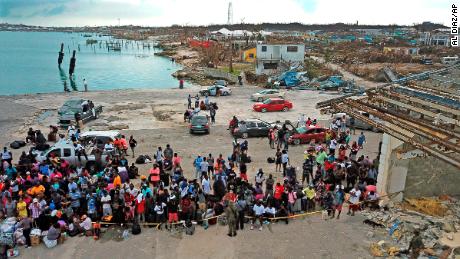Humberto is moving away from the Bahamas and was about 210 miles (335 km)northwest of Great Abaco Island and 170 miles (270 km)east of Cape Canaveral, Florida, late Sunday afternoon, according to the National Hurricane Center.The storm's maximum sustained winds are 70 mph and it is moving at 6 mph, according to the center. The storm is slowly strengthening and is expected to become a hurricane Sunday night, the center said in its latest update.The storm is forecast to continue moving away from the Bahamas and remain well offshore of Florida's east coast through Wednesday, the center said. The storm will generate swells that will affect the northwestern Bahamas and the US coast from east-central Florida to North Carolina during the next few days. The swells could cause life-threatening surf and rip current conditions, forecasters say.
Fears of a second storm
There was concern about what Humberto would bring to the Bahamas, where hundreds are still missing after the Category 5 Hurricane Dorian hit the Abaco Islands and Grand Bahama. The death toll currently stands at 50 but search and rescue teams are still searching through destroyed neighborhoods. "Even if you're just talking 2 to 4 inches (of rain), you have to remember a lot of these homes, they don't have roofs on them. A lot of the buildings are already structurally compromised, so even a 50- or 60-mph wind can cause even more damage," CNN meteorologist Allison Chinchar said.The islands did get some rain, Van Dam said, but did not get Humberto's full impact."They were spared the heaviest rain and the strongest winds, which were centered north and east of the storm," CNN Meteorologist Derek Van Dam said, adding the storm surge in the Bahamas was negligible.
"Even if you're just talking 2 to 4 inches (of rain), you have to remember a lot of these homes, they don't have roofs on them. A lot of the buildings are already structurally compromised, so even a 50- or 60-mph wind can cause even more damage," CNN meteorologist Allison Chinchar said.The islands did get some rain, Van Dam said, but did not get Humberto's full impact."They were spared the heaviest rain and the strongest winds, which were centered north and east of the storm," CNN Meteorologist Derek Van Dam said, adding the storm surge in the Bahamas was negligible.
Evacuees from Dorian
Many in the Bahamas areRead More – Source






